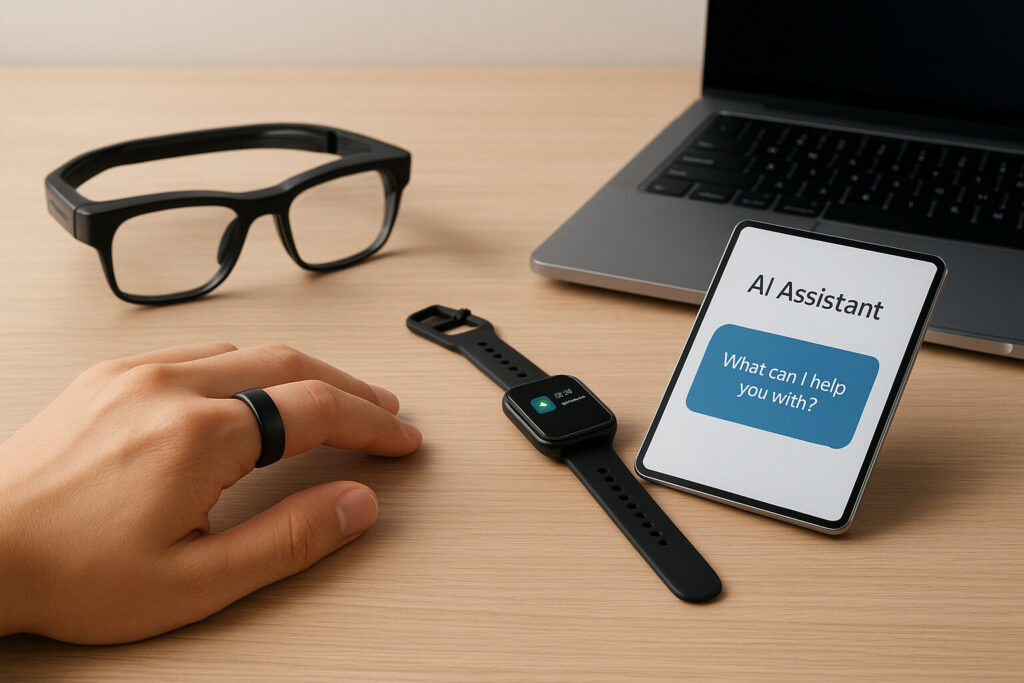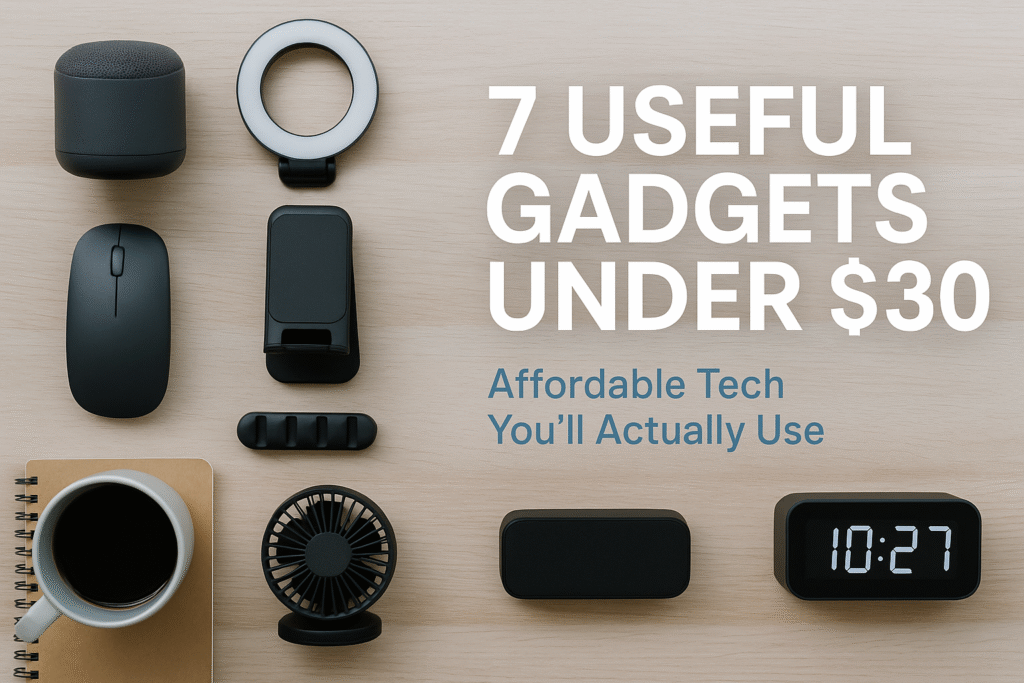1. Introduction
What if a gadget could actually boost your brainpower? I know it sounds like marketing hype, but here’s what’s really happening. We’re living in a time where tools do way more than just entertain us. They can actually sharpen memory, improve focus, and speed up learning. Simply put, gadgets that make you smarter already exist—and they’re becoming part of everyday life.
But what does “smarter” really mean? It’s not about becoming a genius overnight. Smarter means remembering more names at a meeting. Smarter means focusing longer during study sessions. Smarter means learning a new language faster or making better choices at work. This is where gadgets come in. They help us train our brains, save mental energy, and extend what we can do naturally.
Think about smart pens that capture notes instantly, or noise-cancelling headphones that create deep focus. Consider AI tutors that give real-time feedback, or sleep trackers that reveal how rest shapes your thinking. These gadgets don’t just assist—they become companions for a sharper mind.
In this article, we’ll explore the devices designed for learning, memory, productivity, and even daily routines. By the end, you’ll see how using the right gadget can be less about dependency and more about unlocking hidden potential.
2. Why Gadgets Can Actually Boost Intelligence
Your brain never stops adapting. Scientists call this amazing ability plasticity. Each new experience creates fresh pathways. Every habit rewires connections. Gadgets that make you smarter tap into this same principle. They create triggers that help your brain learn, focus, and recall more effectively.
Picture a gadget as your external brain assistant. Your memory has limits, but tools can extend it. A smartwatch that reminds you of tasks saves mental energy. A language-learning app tracks progress and adapts to your pace. A focus timer breaks study sessions into manageable chunks. Each device reduces friction and keeps your brain free for higher-level thinking.
Real-world examples show this clearly. Wearables track sleep, and better sleep means sharper recall. Digital notebooks capture every idea, so nothing slips away. AI-driven tutors explain complex topics instantly, bridging the gap between confusion and clarity. Even noise-cancelling headphones boost cognition by cutting distractions and giving your mind quiet space to concentrate.
Here’s the key point: these gadgets don’t replace intelligence. They support it. By handling reminders, structuring routines, or filtering noise, they free mental bandwidth. What you get is a brain that feels lighter and works faster.
This is exactly why gadgets matter. They act as partners in growth, not crutches. With the right device, you extend what nature already built. In the next section, we’ll explore smart learning gadgets that make studying easier and help knowledge stick longer.
3. Smart Gadgets for Learning Faster
Learning isn’t just about books and notes anymore. Technology has brought us smart learning gadgets that break down barriers and speed up the process. These devices make studying smoother for both students and professionals. They don’t replace effort, but they cut through friction that often slows learning down.
Take smart pens, for instance. A smart pen records handwriting and turns it into digital text. Notes become searchable within seconds. Instead of digging through piles of paper, you type a keyword and find the answer. Your brain stays focused on the concept, not on hunting for missing notes.
Digital notebooks take this even further. They allow writing, sketching, and storing data in the cloud. A student can solve math problems on a page, sync them online, and review them later on any device. For professionals, digital notebooks organize meeting notes and ideas in a structure that saves time. The less time spent organizing, the more time left for actual learning.
Then there are e-readers with AI summarizers. Reading long textbooks can overwhelm anyone. AI-powered devices scan chapters and produce concise summaries. You still absorb the core message, but without drowning in details. This feature is powerful for test preparation or quick knowledge refreshers before important meetings.
These gadgets do one simple thing: they remove obstacles between the learner and the lesson. By capturing, storing, and simplifying information, they keep your mind free to think, connect, and create. That’s why smart learning gadgets are becoming standard tools in classrooms, offices, and homes.
In the next section, we’ll explore gadgets that go beyond learning. They improve memory and focus, two areas vital for sharper thinking.
4. Gadgets That Improve Memory and Focus
Sharp memory and steady focus define real intelligence. Without them, learning feels scattered and work feels overwhelming. Modern tools step in here. They give your brain support and keep attention steady. These are the gadgets to boost brain power that many people now rely on daily.
Let’s start with memory. Wearables that deliver reminders keep schedules on track. A smartwatch can vibrate when a task is due, freeing your mind from constant checking. AI task managers add another layer. They learn patterns, predict priorities, and organize lists automatically. Instead of worrying about what comes next, your brain can focus on doing the task itself. Memory gadgets extend capacity, making recall sharper without extra effort.
Focus gadgets take a different approach. Noise-cancelling headphones block distractions instantly. In a busy home or office, silence gives your mind clear space to think. Pomodoro timers bring structure by dividing time into short, focused bursts. This rhythm helps your brain stay alert without burning out. Brainwave devices go one step further. They track attention levels and use gentle signals to guide your mind back when it drifts.
Each of these tools follows the same rule: reduce noise, reduce friction, and free space for deeper thought. By handling external clutter, they let your brain invest energy in ideas that matter. Students use them to study longer without fatigue. Professionals rely on them to finish tasks faster and with fewer mistakes.
These gadgets to boost brain power show that technology can protect focus and sharpen memory. In the next section, we’ll shift to productivity boosters—devices that make you not only think better but also work smarter.
5. Productivity Boosters That Make You Smarter at Work
Work today demands quick choices and clear focus. Small delays pile up into wasted hours. This is where gadgets for productivity make a real difference. They don’t just save time. They also sharpen decision-making, which makes you a smarter worker.
Think about smart desks. These adjustable desks improve posture and energy levels. A worker who feels alert thinks faster. Some desks even track sitting and standing habits, nudging you to move at the right time. Better posture leads to better blood flow, which supports clearer thinking. Your desk becomes more than furniture—it becomes a silent partner in focus.
Multi-tasking screens add another layer of efficiency. Ultra-wide monitors or dual-screen setups reduce the need to switch windows. With more space, you compare documents, analyze data, or design projects without constant clicks. Your brain stays with the task instead of breaking flow. For professionals handling numbers, creative work, or research, the benefit is immediate.
AI-driven planners take planning stress away. These tools analyze your calendar, spot conflicts, and recommend ideal schedules. They can even assign priorities to tasks based on urgency. Instead of juggling deadlines, you follow a clear, optimized plan. Decision fatigue fades, leaving more energy for actual problem-solving.
Together, these gadgets transform workflow. A smart desk keeps your body engaged. A multi-tasking screen reduces mental strain. An AI planner keeps priorities clear. Each tool boosts performance by saving small units of time and focus that would otherwise be lost.
That’s the value of gadgets for productivity. They free workers from micro-decisions and distractions, leaving space for insight and creativity. In the next section, we’ll explore AI gadgets that push learning and cognition even further.
6. AI Gadgets That Push Cognitive Limits
Artificial intelligence isn’t just stuck in software anymore. It now powers devices designed to extend how we think and learn. These AI gadgets for learning act as partners for your brain. Together, they create what experts call extended intelligence.
Look at AI tutors. Unlike static textbooks, these digital coaches adapt in real time. They track your progress, identify weak spots, and deliver personalized lessons. If you struggle with math, the tutor slows down and offers step-by-step guidance. If you master a concept quickly, it shifts to the next challenge. What you get is learning that feels tailored, not generic.
Language learning earbuds offer another breakthrough. They translate speech instantly and help users practice pronunciation. Imagine traveling abroad and understanding locals in seconds. Or picture a student practicing a new language while commuting. The earbuds remove barriers that once slowed global communication.
Then there are real-time translation devices. These pocket-sized tools convert conversations across multiple languages without delay. Professionals use them in meetings. Travelers use them to navigate foreign streets. Students use them to access content once locked behind language walls.
What makes these gadgets unique is their ability to work with your brain, not against it. They don’t replace intelligence. They amplify it. By cutting delays, simplifying learning, and removing language barriers, they create room for deeper focus and faster growth.
That’s why AI gadgets for learning represent the next step in smart technology. They push the limits of cognition and show how humans and AI can thrive together.

7. Best Everyday Gadgets That Quietly Make You Smarter
Not every smart device feels high-tech. Some work quietly in the background, yet they bring big gains for your mind. These are the best gadgets for students / daily use, because they fit easily into routines while improving cognition.
Smart glasses are one example. They display notifications, maps, or translations without pulling out your phone. This saves time and reduces distraction. For students, smart glasses can overlay study notes. For professionals, they can guide presentations or technical tasks. By keeping information in view, they make thinking faster and more fluid.
Sleep trackers also play a key role. Good sleep fuels sharp memory and focus. A tracker records patterns, measures rest quality, and suggests improvements. When sleep improves, so does attention span and problem-solving ability. In this way, better nights create smarter days.
Health wearables extend the same principle. Devices that monitor heart rate, activity, or stress provide instant feedback. Small changes, like moving more or calming breathing, lead to stronger brain performance. A healthier body means a sharper mind.
These gadgets don’t shout for attention. They work silently, guiding small daily choices that build lasting mental strength. That’s why the best gadgets for students / daily use matter—they make smarter living a habit, not an exception.
8. The Psychology of Feeling Smarter with Tech
Sometimes the biggest shift comes from belief, not hardware. Psychology shows that when people feel smarter, they often act smarter. This is the placebo effect in action. Gadgets play into this by serving as confidence boosters.
Wearing a smartwatch that tracks focus can make you more mindful of attention. Using a digital notebook can make you feel organized before you even start writing. Sliding on noise-cancelling headphones can create the sense of control that leads to deeper concentration. Each device signals readiness, and the brain responds by working harder and more effectively.
The boost may begin as perception, but it quickly turns into performance. Confidence lowers stress. Lower stress improves recall, creativity, and decision-making. That loop explains why gadgets often deliver more than their core function. They change how you see yourself.
In short, gadgets act not just as tools but as psychological triggers. They make you believe in your ability, and that belief makes you smarter.
9. Future of Gadgets That Make You Smarter
The gadgets we use today are just the beginning. The future points to devices that connect more directly with the brain. These next steps promise even greater ways to extend intelligence.
Neural interface devices are already in development. They aim to link thoughts with machines. Imagine typing a message by simply thinking the words, or recalling information without searching a screen. Early prototypes show how signals from the brain can control digital tools. With time, these interfaces may support memory training, skill learning, or even mood regulation.
Brain–computer interfaces push this vision further. Instead of just reading signals, they can send information back. A student could receive feedback in real time. A worker could process complex data without scrolling through endless reports. The brain becomes the hub, and the gadget becomes the channel.
On the consumer side, smaller but smarter devices will soon enter daily life. Glasses with built-in AI tutors, earbuds that translate flawlessly, or health wearables that predict stress before it appears. These tools will be designed for everyday use, not just labs.
The path is clear: future gadgets will not only support intelligence but blend with it. The line between human and machine will fade, leaving a partnership built for smarter living.
10. Conclusion
The journey through this article shows one clear truth: gadgets that make you smarter are not science fiction. They exist now, and they touch nearly every part of daily life. From smart pens and AI tutors to sleep trackers and neural interfaces, these devices prove that technology can sharpen memory, improve focus, and speed up learning. They do not replace intelligence. They extend it.
The reason is simple. Gadgets take on the small tasks that drain energy. They remind us of schedules, filter distractions, and organize knowledge. When those barriers fall, the brain works faster and feels lighter. In that way, smart devices unlock potential already inside us.
The future looks even brighter. Gadgets will grow smaller, smarter, and more personal. They will not just assist learning but merge with it. Every step forward will blur the line between natural and extended intelligence.
So the real question becomes personal: which gadget would you try first? Will you pick a digital notebook for better notes, a smartwatch for sharper memory, or AI earbuds for faster learning? The choice matters, because the first step toward smarter living starts with action.
The tools are here. The decision is yours.
Frequently Asked Questions
1. Do gadgets really make you smarter?
Yes, gadgets that make you smarter can improve how you think, learn, and remember. Smart gadgets like note-taking apps, AI assistants, and memory tools reduce effort, so your brain focuses better. When tasks become easier, you gain more energy for problem-solving. Gadgets don’t replace intelligence; they support it by keeping information clear, organized, and accessible.
2. Which gadgets are best for boosting memory?
Smart gadgets that make you smarter include memory trainers, reminder apps, and smart notebooks. These tools keep ideas close to you, so forgetting becomes less common. Digital journals, wearable trackers, and AI-powered planners strengthen recall. With the right gadget, memory works faster and stays sharper. Simple daily use builds habits that help memory long-term.
3. Can gadgets improve learning speed?
Yes, gadgets that make you smarter speed up learning by simplifying study. E-readers, translation apps, and voice recorders save time, so you absorb more quickly. Visual learners gain from digital flashcards, while auditory learners benefit from AI tutors. Gadgets adapt to your style, making learning efficient. With these tools, knowledge grows faster than traditional methods.
4. Are smart gadgets affordable?
Many gadgets that make you smarter are budget-friendly. Note-taking apps, productivity trackers, and browser extensions cost little or are free. Even smart pens and wearable rings are becoming cheaper as technology spreads. Prices vary, but options exist for every budget. Smart gadgets give long-term value because they save time, reduce mistakes, and improve productivity.
5. Do gadgets reduce focus instead of improving it?
Gadgets that make you smarter increase focus when used wisely. Distraction comes from poor use, not from the gadget itself. Productivity timers, noise-canceling headphones, and AI task managers limit interruptions. When you use gadgets with intent, focus grows stronger. Smart use transforms devices into tools for deep work, not sources of wasted time.
6. Can gadgets replace human intelligence?
No, gadgets that make you smarter cannot replace human intelligence. They support, enhance, and expand abilities, but creativity and judgment stay human. A smart notebook organizes notes; it doesn’t write ideas for you. AI assistants guide research; they don’t set goals. Gadgets complement intelligence, but real wisdom, insight, and imagination still belong to humans.
7. Which gadget should I try first?
The best gadget that makes you smarter depends on your daily needs. Students may start with a smart notebook; professionals may try an AI assistant. Writers love digital pens, while entrepreneurs benefit from productivity trackers. Begin with one gadget, use it daily, and measure results. Small steps show how gadgets shape smarter habits over time.
Also read:
Top 10 AI Gadgets Every Pet Owner Needs in 2025
AI vs Human Creativity: Where Do We Draw the Line?
Are Digital Devices Altering Our Brains? – Scientific American



